Manipulate A2/B2 Structures in AlCrFexNi Alloys for Improved Mechanical Properties and Wear Resistance
Abstract
:1. Introduction
2. Experimental Procedures
2.1. Materials Preparation
2.2. Microstructure Characterization
2.3. Mechanical Property Evaluation
2.4. Wear Tests
3. Results
3.1. Initial Structures
3.2. Mechanical Properties
3.3. Wear Behavior
4. Conclusions
Author Contributions
Funding
Data Availability Statement
Conflicts of Interest
References
- Li, J.L.; Li, Z.; Wang, Q.; Dong, C.; Liaw, P.K. Phase-field simulation of coherent BCC/B2 microstructures in high entropy alloys. Acta Mater. 2020, 197, 10–19. [Google Scholar] [CrossRef]
- Jin, D.; Wang, Z.; Yuan, J.; Jiang, B.; Yu, F.; Li, J.; Wang, Q. High-strength and energetic Al2Ti6Zr2Nb3Ta3 high entropy alloy containing a cuboidal BCC/B2 coherent microstructure. J. Alloys Compd. 2023, 931, 167546. [Google Scholar] [CrossRef]
- Liu, L.; Zhang, Y.; Han, J.; Wang, X.; Jiang, W.; Liu, C.T.; Zhang, Z.; Liaw, P.K. Nanoprecipitate-Strengthened High-Entropy Alloys. Adv. Sci. 2021, 8, e2100870. [Google Scholar] [CrossRef]
- Wang, X.G.; Liu, J.L.; Jin, T.; Sun, X.F. The effects of ruthenium additions on tensile deformation mechanisms of single crystal superalloys at different temperatures. Mater. Des. 2014, 63, 286–293. [Google Scholar] [CrossRef]
- Li, Z.M.; Li, X.N.; Hu, Y.L.; Zheng, Y.H.; Yang, M.; Li, N.J.; Bi, L.X.; Liu, R.W.; Wang, Q.; Dong, C.; et al. Cuboidal γ’ phase coherent precipitation-strengthened Cu–Ni–Al alloys with high softening temperature. Acta Mater. 2021, 203, 116458. [Google Scholar] [CrossRef]
- Ma, Y.; Hao, J.; Wang, Q.; Zhang, C.; Li, C.; Dong, C. Temperature-affected microstructural stability of coherent cuboidal B2 particles in precipitation-strengthened body-centered-cubic Al0.7CoCr2FeNi high-entropy alloy. J. Mater. Sci. 2019, 54, 8696–8710. [Google Scholar] [CrossRef]
- Thompson, M.E.; Su, C.S.; Voorhees, P.W. The equilibrium shape of a misfitting precipitate. Acta Metall. Mater. 1994, 42, 2107–2122. [Google Scholar] [CrossRef]
- Hou, J.-X.; Cao, B.-X.; Xiao, B.; Jiao, Z.-B.; Yang, T. Compositionally complex coherent precipitation-strengthened high-entropy alloys: A critical review. Rare Met. 2022, 41, 2002–2015. [Google Scholar] [CrossRef]
- Chen, X.; Qi, J.Q.; Sui, Y.W.; He, Y.Z.; Wei, F.X.; Meng, Q.K.; Sun, Z. Effects of aluminum on microstructure and compressive properties of Al-Cr-Fe-Ni eutectic multi-component alloys. Mater. Sci. Eng. A 2017, 681, 25–31. [Google Scholar] [CrossRef]
- Wang, H.; Zhang, W.; Gao, P.; Xiang, Q.; Qu, Y.; Cheng, J.; Ren, Y.; Yu, B.; Qiu, K. AlxCrFeNi medium entropy alloys with high damping capacity. J. Alloys Compd. 2021, 876, 159991. [Google Scholar] [CrossRef]
- Wang, M.; Wen, Z.; Liu, J.; Ma, B.; Wang, M.; Zou, Z.; Zhao, Y. Labyrinthine structure Al CrFeNi (x ≥ 1) eutectic high entropy alloys with duplex reinforced phases. J. Alloys Compd. 2022, 918, 165441. [Google Scholar] [CrossRef]
- Wang, M.; Wen, Z.; Ma, B.; Liu, J.; Zou, Z.; Zhao, Y. Enhancing the strength of AlCrFeNi HEAs via tailoring aluminum content and optimal aging treatment. J. Alloys Compd. 2022, 893, 162242. [Google Scholar] [CrossRef]
- Liu, F.; Song, Q.; Chen, R.; Li, W.; Song, X.; Sun, J.; Wang, C. Effects of Al and Co contents on the microstructure and properties of AlxCoCryFeNi high-entropy alloys. Mater. Charact. 2023, 203, 113108. [Google Scholar] [CrossRef]
- Qin, G.; Xue, W.; Fan, C.; Chen, R.; Wang, L.; Su, Y.; Ding, H.; Guo, J. Effect of Co content on phase formation and mechanical properties of (AlCoCrFeNi)100-xCox high-entropy alloys. Mater. Sci. Eng. A 2018, 710, 200–205. [Google Scholar] [CrossRef]
- Lu, Y.; Gao, X.; Dong, Y.; Wang, T.; Chen, H.L.; Maob, H.; Zhao, Y.; Jiang, H.; Cao, Z.; Li, T.; et al. Preparing bulk ultrafine-microstructure high-entropy alloys via direct solidification. Nanoscale 2018, 10, 1912–1919. [Google Scholar] [CrossRef] [PubMed]
- Jiang, H.; Li, L.; Wang, R.; Han, K.; Wang, Q. Effects of Chromium on the Microstructures and Mechanical Properties of AlCoCrxFeNi2.1 Eutectic High Entropy Alloys. Acta Metall. Sin. Engl. Lett. 2021, 34, 1565–1573. [Google Scholar] [CrossRef]
- Cao, L.; Wang, X.; Wang, Y.; Zhang, L.; Yang, Y.; Liu, F.; Cui, Y. Microstructural evolution, phase formation and mechanical properties of multi-component AlCoCrFeNix alloys. Appl. Phys. A 2019, 125, 699. [Google Scholar] [CrossRef]
- Tian, Q.W.; Zhang, G.J.; Yin, K.X.; Cheng, W.L.; Wang, Y.N.; Huang, J.C. Effect of Ni content on the phase formation, tensile properties and deformation mechanisms of the Ni-rich AlCoCrFeNix (x = 2, 3, 4) high entropy alloys. Mater. Charact. 2021, 176, 111148. [Google Scholar] [CrossRef]
- Takeuchi, A.; Inoue, A. Classification of Bulk Metallic Glasses by Atomic Size Difference, Heat of Mixing and Period of Constituent Elements and Its Application to Characterization of the Main Alloying Element. Mater. Trans. 2005, 46, 2817–2829. [Google Scholar] [CrossRef]
- Xiao, Y.; Chang, X.; Peng, X.; Fu, T. Heterogeneous structure induced excellent mechanical and wear properties in Co-free FeCrAlNi medium-entropy alloys. J. Mater. Res. Technol. 2022, 18, 4169–4180. [Google Scholar] [CrossRef]
- Wu, M.; Yuan, J.; Diao, G.; Li, D. Achieving a Combination of Higher Strength and Higher Ductility for Enhanced Wear Resistance of AlCrFeNiTi0.5 High-Entropy Alloy by Mo Addition. Metals 2022, 12, 1910. [Google Scholar] [CrossRef]
- Oliver, W.C.; Pharr, G.M. An improved technique for determining hardness and elastic modulus using load and displacement sensing indentation experiments. J. Mater. Res. 1992, 7, 1564–1583. [Google Scholar] [CrossRef]
- Shaysultanov, D.G.; Salishchev, G.A.; Ivanisenko, Y.V.; Zherebtsov, S.V.; Tikhonovsky, M.A.; Stepanov, N.D. Novel Fe36Mn21Cr18Ni15Al10 high entropy alloy with bcc/B2 dual-phase structure. J. Alloys Compd. 2017, 705, 756–763. [Google Scholar] [CrossRef]
- Sistla, H.R.; Newkirk, J.W.; Liou, F.F.; Al, E.O. Heat treatment on phase transformations and microstructure of AlxFeCoCrNi2−x (x = 0.3, 1) high entropy alloys. Mater. Des. 2015, 81, 113–121. [Google Scholar] [CrossRef]
- Kao, Y.-F.; Chen, T.-J.; Chen, S.-K.; Yeh, J.-W. Microstructure and mechanical property of as-cast, -homogenized, and -deformed AlxCoCrFeNi (0 ≤ x ≤ 2) high-entropy alloys. J. Alloys Compd. 2009, 488, 57–64. [Google Scholar] [CrossRef]
- Wang, T.; Wu, Y.; Yang, Y.; Tian, S.; Zhang, Y.; Jiang, H. Effect of Al/Ni ratio on phase, microstructure and mechanical properties of the AlxCrFeMnNi2−x high entropy alloys. J. Alloys Compd. 2023, 941, 168760. [Google Scholar] [CrossRef]
- Jiang, H.; Han, K.; Li, D.; Cao, Z. Synthesis and Characterization of AlCoCrFeNiNbx High-Entropy Alloy Coatings by Laser Cladding. Crystals 2019, 9, 56. [Google Scholar] [CrossRef]
- Mishra, K.; Singh, A. Effect of interlamellar spacing on fracture toughness of nano-structured pearlite. Mater. Sci. Eng. A 2017, 706, 22–26. [Google Scholar] [CrossRef]
- Xu, P.; Liang, Y.; Li, J.; Meng, C. Further improvement in ductility induced by the refined hierarchical structures of pearlite. Mater. Sci. Eng. A 2019, 745, 176–184. [Google Scholar] [CrossRef]
- Narayanaswamy, B.; Hodgson, P.; Beladi, H. Comparisons of the two-body abrasive wear behaviour of four different ferrous microstructures with similar hardness levels. Wear 2016, 350–351, 155–165. [Google Scholar] [CrossRef]
- Diao, G.; Yan, Q.; Shi, X.; Zhang, X.; Wen, Z.; Jin, X. Improvement of wear resistance in ferrite-pearlite railway wheel steel via ferrite strengthening and cementite spheroidization. Mater. Res. Express 2019, 6, 106513. [Google Scholar] [CrossRef]
- Xu, X.; Xu, W.; Ederveen, F.H.; Zwaag, S.V.D. Design of low hardness abrasion resistant steels. Wear 2013, 301, 89–93. [Google Scholar] [CrossRef]
- Ma, Y.; Jiang, B.; Li, C.; Wang, Q.; Dong, C.; Liaw, P.K.; Xu, F.; Sun, L. The BCC/B2 morphologies in Al x NiCoFeCr high-entropy alloys. Metals 2017, 7, 57. [Google Scholar] [CrossRef]
- Kloenne, Z.T.; Couzinié, J.-P.; Heczko, M.; Gröger, R.; Viswanathan, G.B.; Clark, W.A.T.; Fraser, H.L. On the bcc/B2 interface structure in a refractory high entropy alloy. Scr. Mater. 2023, 223, 115071. [Google Scholar] [CrossRef]
- Joseph, J.; Stanford, N.; Hodgson, P.; Fabijanic, D.M. Understanding the mechanical behaviour and the large strength/ductility differences between FCC and BCC AlxCoCrFeNi high entropy alloys. J. Alloys Compd. 2017, 726, 885–895. [Google Scholar] [CrossRef]
- Ma, Y.; Wang, Q.; Jiang, B.B.; Li, C.L.; Hao, J.M.; Li, X.N.; Dong, C.; Nieh, T.G. Controlled formation of coherent cuboidal nanoprecipitates in body-centered cubic high-entropy alloys based on Al2(Ni,Co,Fe,Cr)14 compositions. Acta Mater. 2018, 147, 213–225. [Google Scholar] [CrossRef]
- Wang, Z.; Jiang, B.; Liu, H.; Niu, B.; Yu, H.; Wang, Q. Microstructural Stability and Strengthening Mechanism of a Ferritic Fe–Cr–Ni–Al Superalloy Containing Cuboidal B2 Nanoparticles. In TMS Annual Meeting & Exhibition; Springer Nature: Cham, Switzerland, 2023; pp. 469–485. [Google Scholar]
- Marquis, E.A.; Seidman, D.N. Nanoscale structural evolution of Al3Sc precipitates in Al(Sc) alloys. Acta Mater. 2001, 49, 1909–1919. [Google Scholar] [CrossRef]
- He, J.Y.; Liu, W.H.; Wang, H.; Wu, Y.; Liu, X.J.; Nieh, T.G.; Lu, Z.P. Effects of Al addition on structural evolution and tensile properties of the FeCoNiCrMn high-entropy alloy system. Acta Mater. 2014, 62, 105–113. [Google Scholar] [CrossRef]
- Yan, X.; Ju, J.; Zuo, L.; Ma, D.; Hu, J.; Zhang, T. Variation of BCC/B2 coherent microstructure and resultant improvement in strength of Al0.7CrxFe 3−xCoNi high-entropy alloys. Mater. Charact. 2023, 203, 113129. [Google Scholar] [CrossRef]
- Diao, G.; He, A.; Li, D.Y.; Wu, M.; Xu, Z.; Li, W.; Li, Q.Y. Tune a highly ductile AlCrFe2Ni4 alloy by Ti addition for desired high mechanical strength. Mater. Sci. Eng. A 2022, 856, 143910. [Google Scholar] [CrossRef]
- Sehitoglu, Y.K.A. Modeling of thermomechanical fatigue damage in coated alloys. Thermomech. Fatigue Behav. Mater. 1993, 1, 17. [Google Scholar]
- Diao, G.J.; He, A.Q.; Tang, Y.Q.; Wu, M.Y.; Zhang, D.; Chen, W.G.; Chen, D.L.; Li, D.Y. Effects of Al and Ti on microstructure, mechanical properties and wear resistance of TiXCrFe2Ni2 alloys. Mater. Sci. Eng. A 2023, 879, 145242. [Google Scholar] [CrossRef]

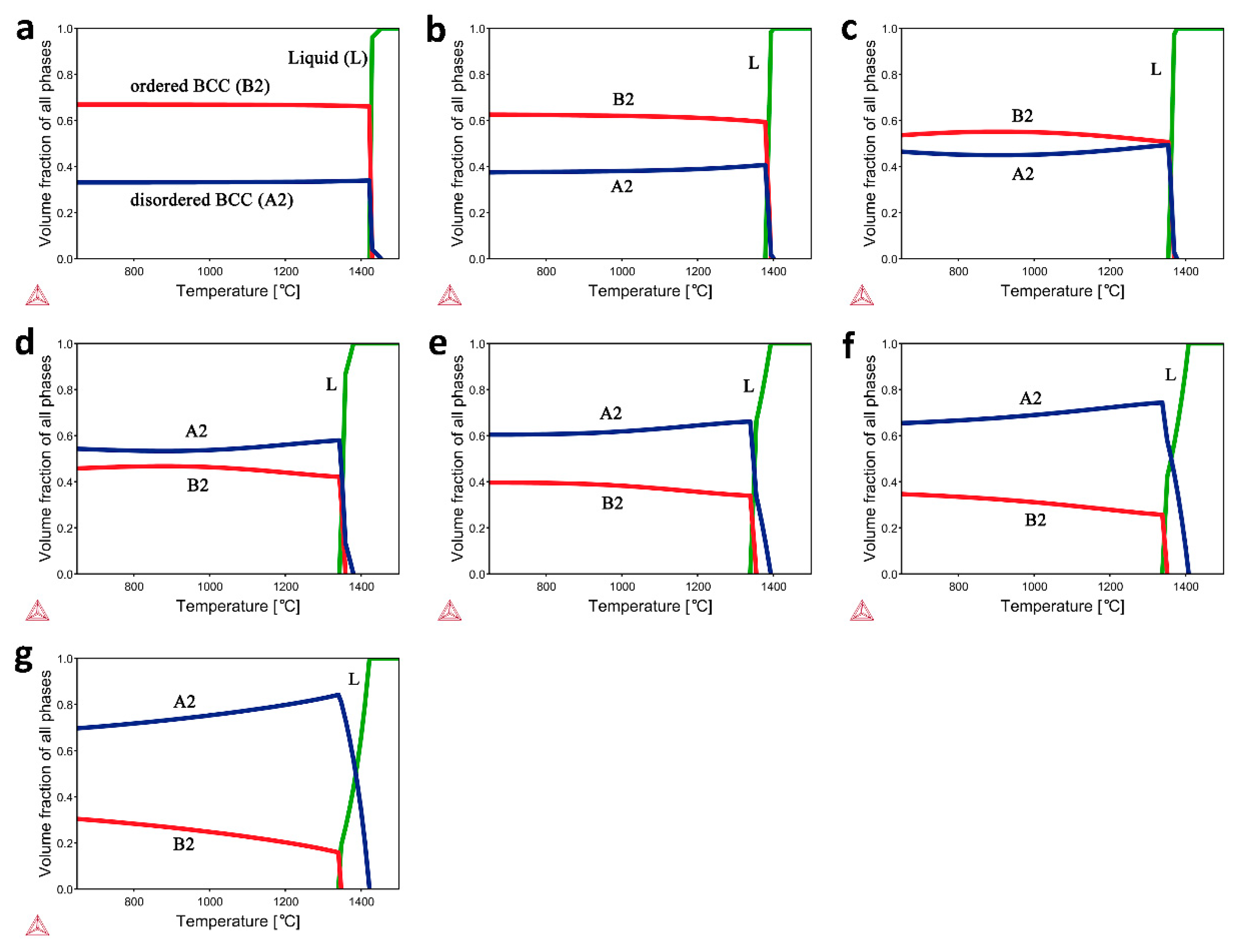
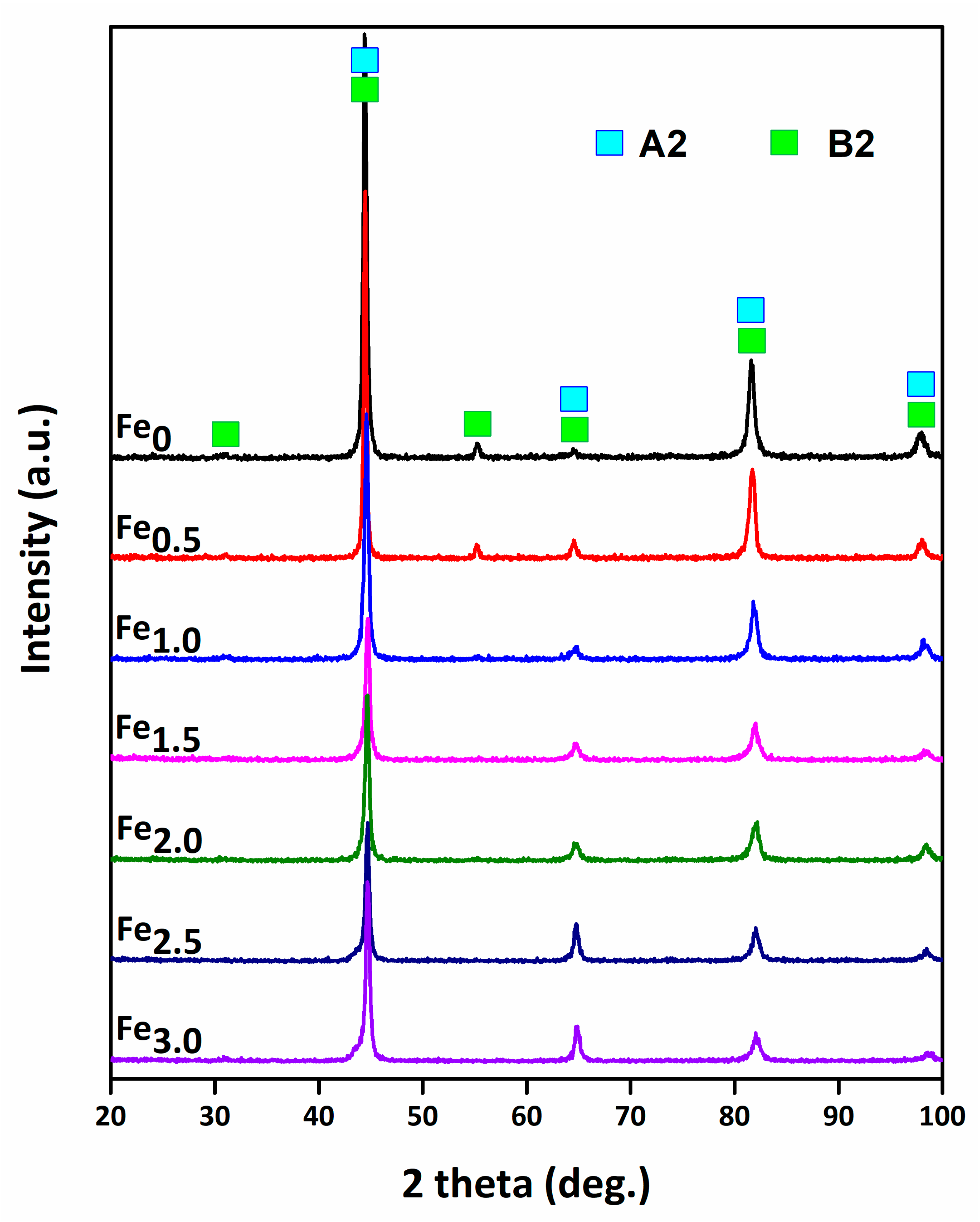

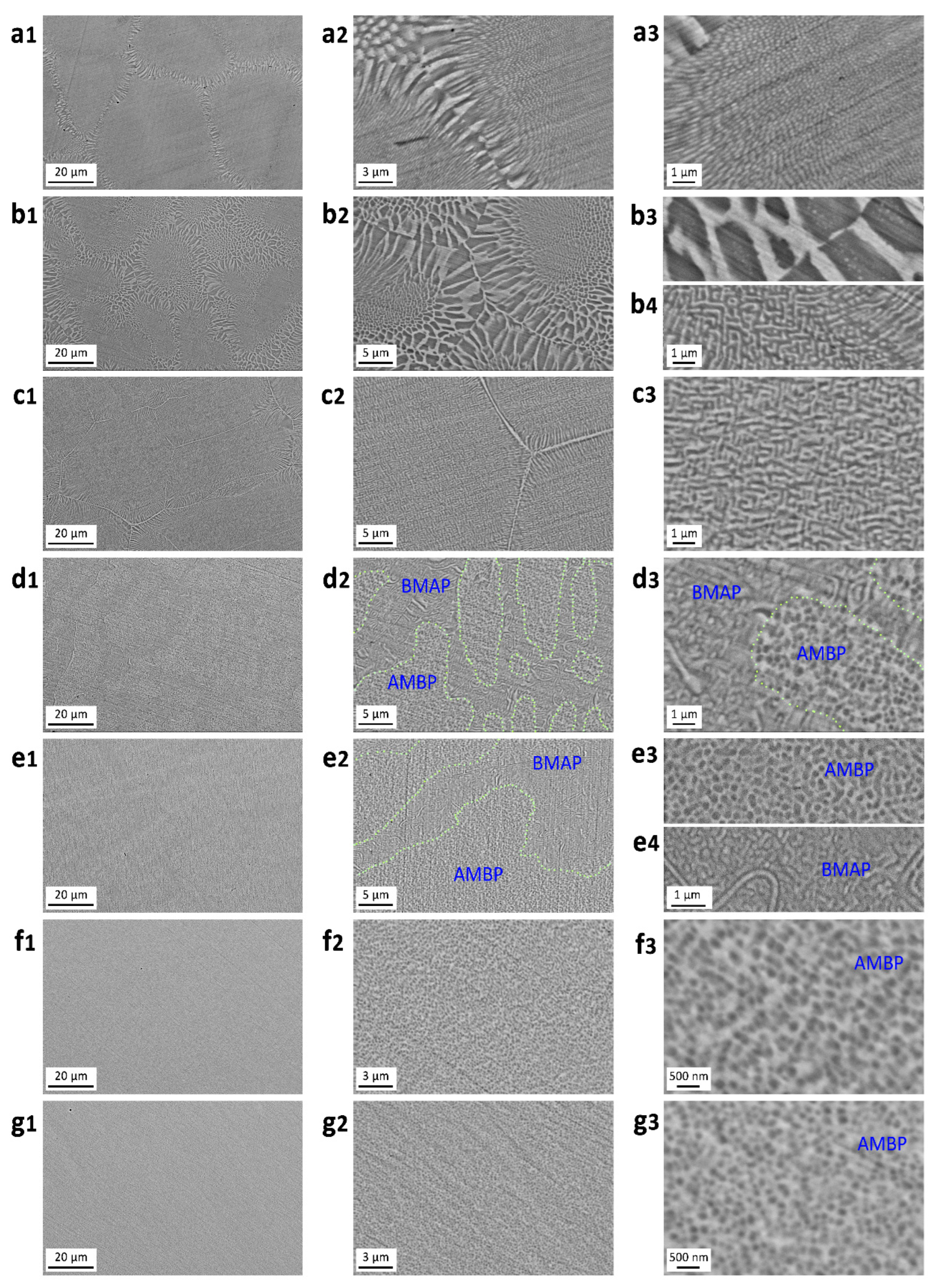
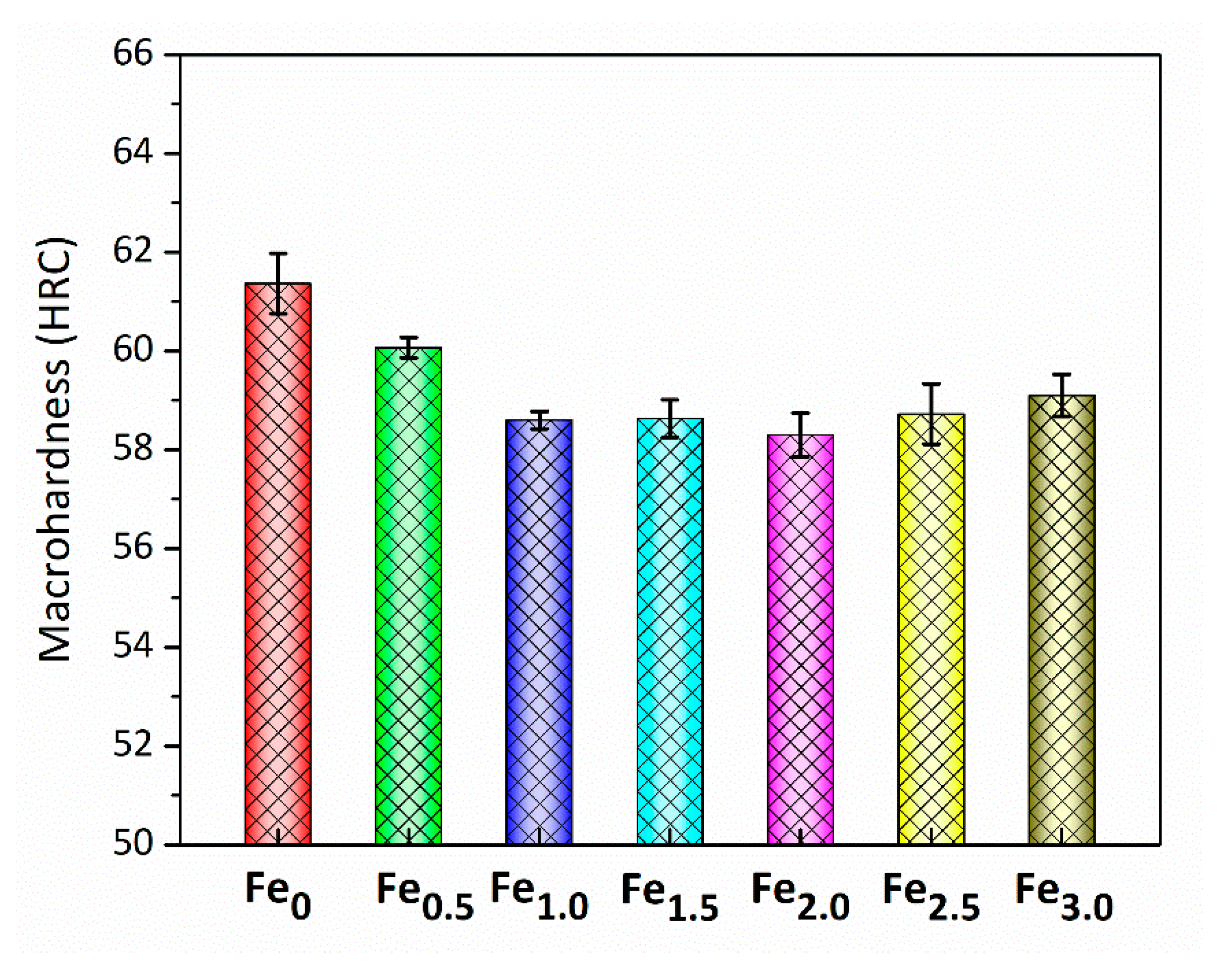
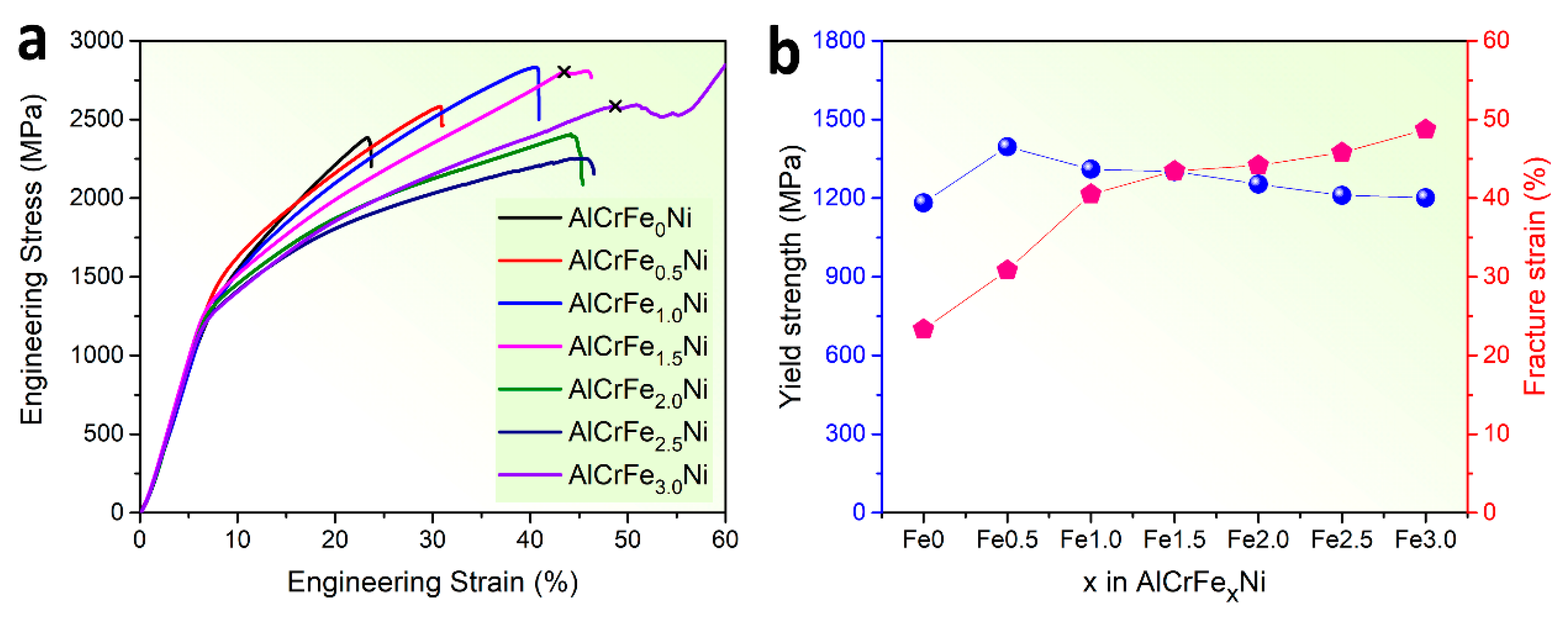
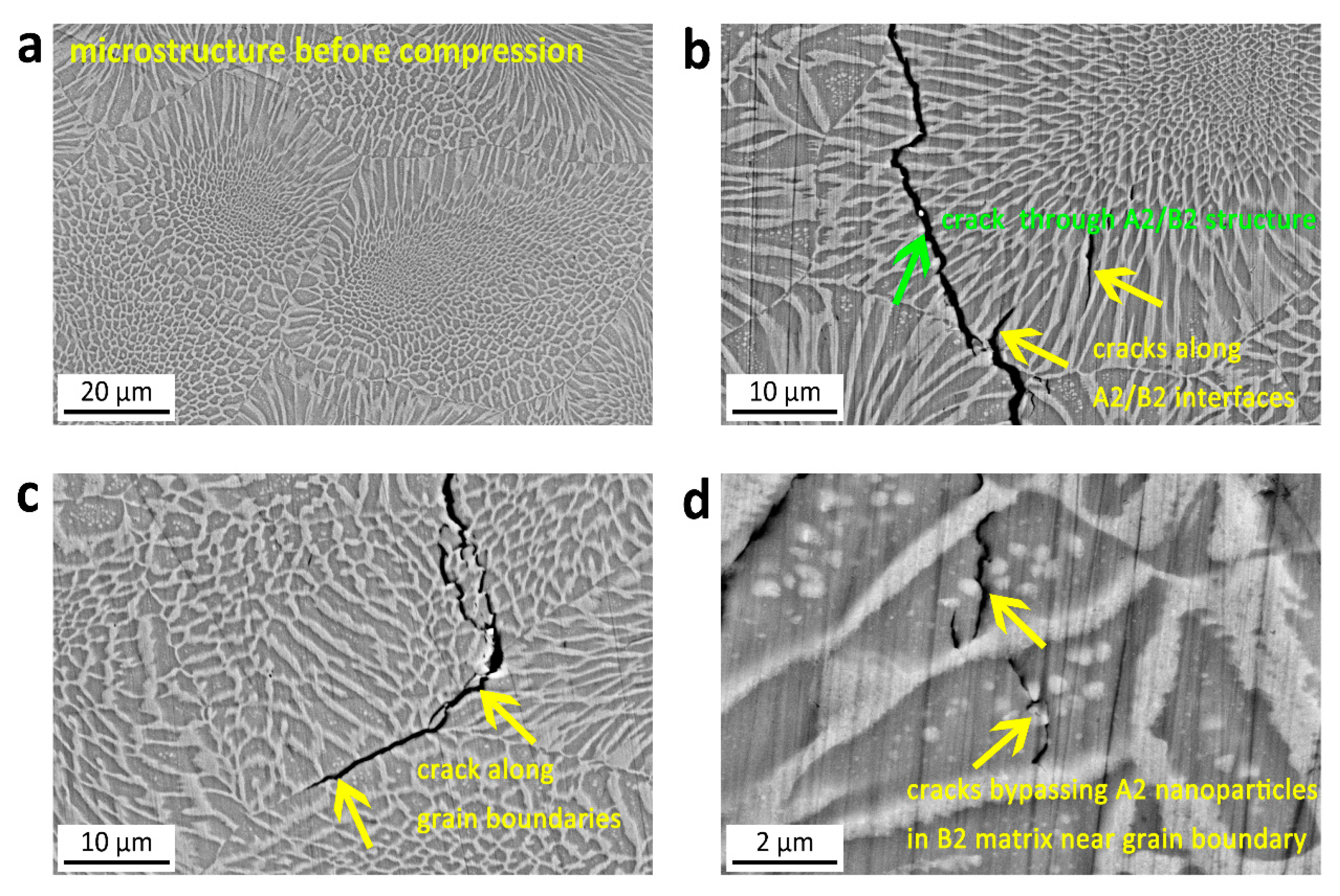
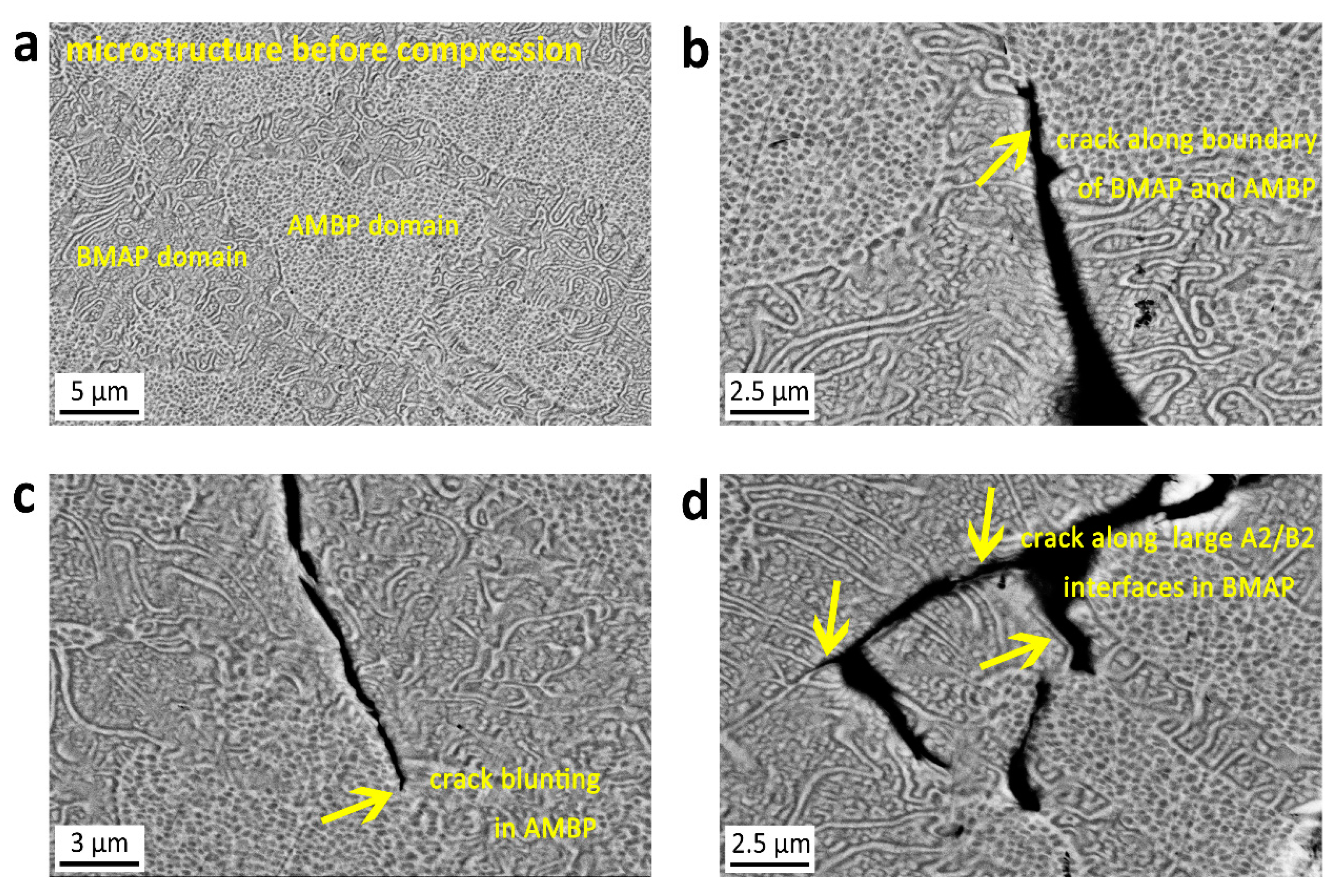


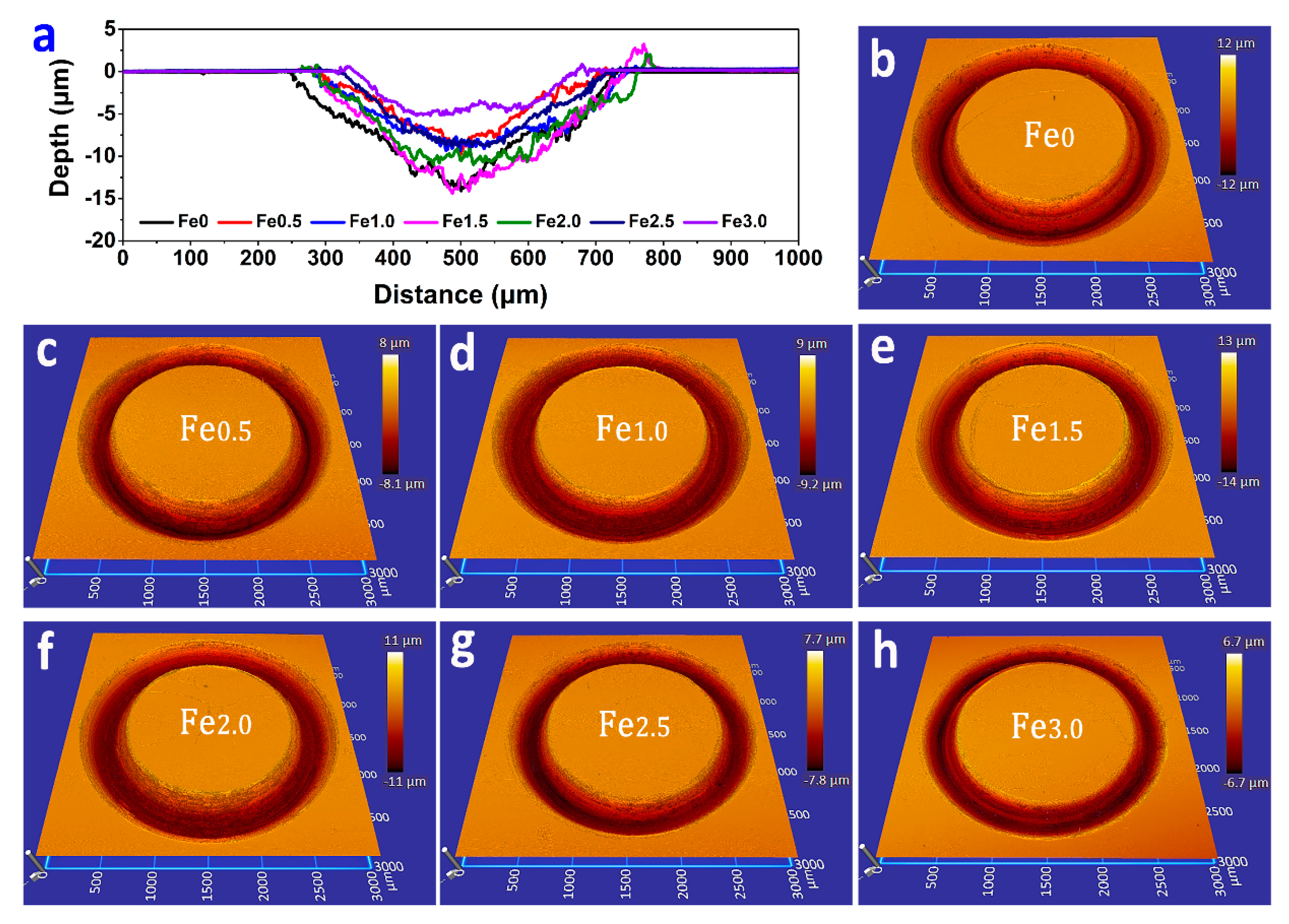
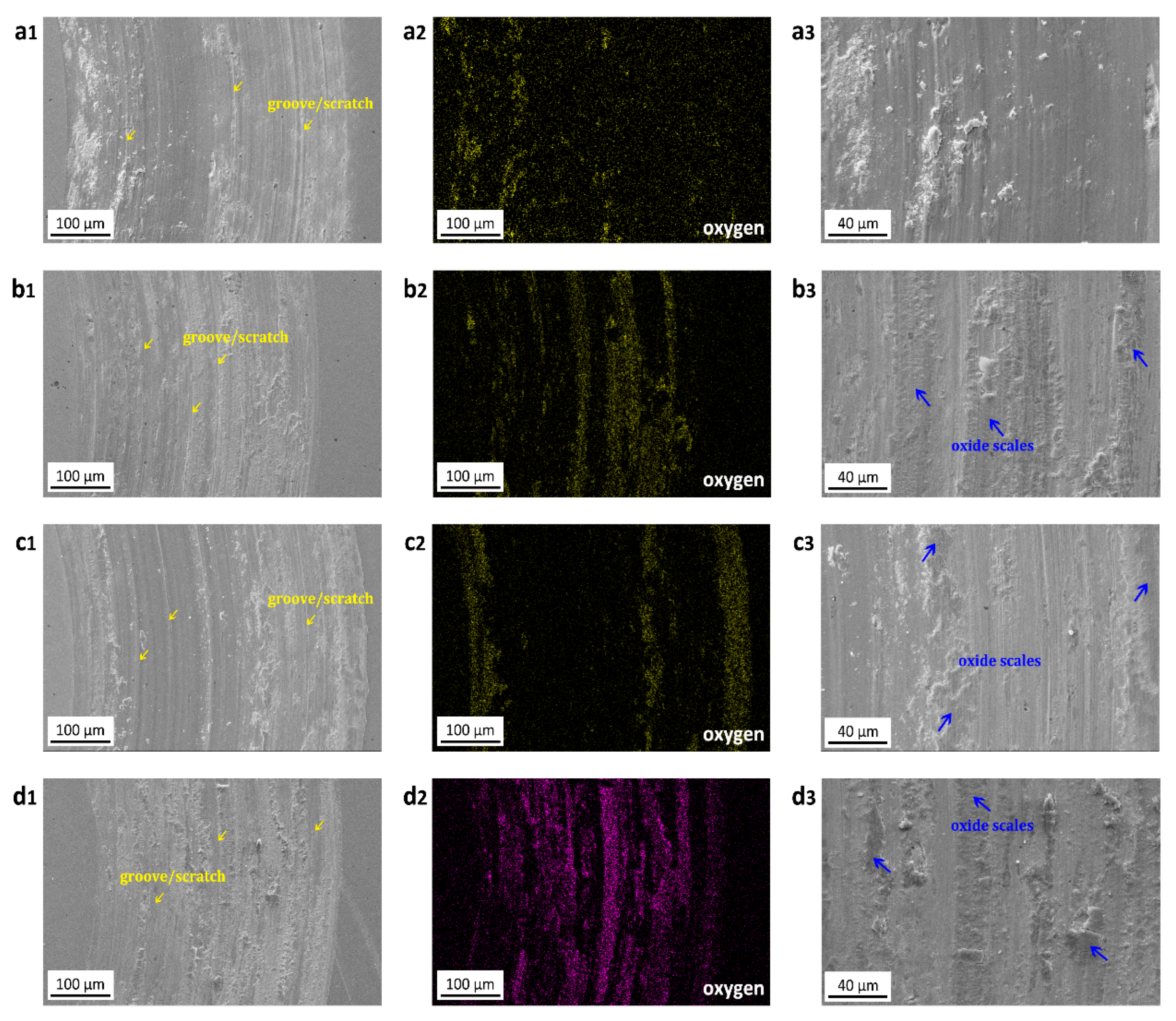
| Alloys | Al (at.%) | Cr (at.%) | Fe (at.%) | Ni (at.%) |
|---|---|---|---|---|
| AlCrFe0Ni | 33.33 | 33.33 | 0 | 33.34 |
| AlCrFe0.5Ni | 28.57 | 28.57 | 14.29 | 28.57 |
| AlCrFe1.0Ni | 25.00 | 25.00 | 25.00 | 25.00 |
| AlCrFe1.5Ni | 22.22 | 22.22 | 33.33 | 33.33 |
| AlCrFe2.0Ni | 20.00 | 20.00 | 40.00 | 20.00 |
| AlCrFe2.5Ni | 18.18 | 18.18 | 45.46 | 18.18 |
| AlCrFe3.0Ni | 16.66 | 16.67 | 50.00 | 16.67 |
| Phases (Contrast in SEM-BSE Image) | Crystal Structure | Al | Cr | Fe | Ni |
|---|---|---|---|---|---|
| Light phase | A2 | 7.45 | 42.42 | 43.38 | 6.75 |
| Dark phase | B2 | 39.36 | 6.11 | 13.04 | 41.49 |
| Alloys | Yield Strength (MPa) | Peak Strength (MPa) | Fracture Strain (%) | Hardness/HRC | Strain Hardening Rate (MPa/%) |
|---|---|---|---|---|---|
| AlCrFe0Ni | 1182.1 | 2384.5 | 23.31 | 61.4 ± 0.6 | 54.6 |
| AlCrFe0.5Ni | 1396.1 | 2583.7 | 30.83 | 60.1 ± 0.2 | 38.5 |
| AlCrFe1.0Ni | 1309.8 | 2832.7 | 40.51 | 58.6 ± 0.2 | 37.6 |
| AlCrFe1.5Ni | 1301.2 | 2802.2 | 43.46 | 58.6 ± 0.4 | 34.5 |
| AlCrFe2.0Ni | 1253.4 | 2405.6 | 44.16 | 58.3 ± 0.4 | 26.1 |
| AlCrFe2.5Ni | 1210.6 | 2250.7 | 45.79 | 58.7 ± 0.6 | 22.7 |
| AlCrFe3.0Ni | 1201.3 | 2585.1 | 48.71 | 59.1 ± 0.4 | 24.2 |
Disclaimer/Publisher’s Note: The statements, opinions and data contained in all publications are solely those of the individual author(s) and contributor(s) and not of MDPI and/or the editor(s). MDPI and/or the editor(s) disclaim responsibility for any injury to people or property resulting from any ideas, methods, instructions or products referred to in the content. |
© 2023 by the authors. Licensee MDPI, Basel, Switzerland. This article is an open access article distributed under the terms and conditions of the Creative Commons Attribution (CC BY) license (https://creativecommons.org/licenses/by/4.0/).
Share and Cite
Diao, G.; Wu, M.; He, A.; Xu, Z.; Mousavi, S.E.; Li, D. Manipulate A2/B2 Structures in AlCrFexNi Alloys for Improved Mechanical Properties and Wear Resistance. Lubricants 2023, 11, 392. https://doi.org/10.3390/lubricants11090392
Diao G, Wu M, He A, Xu Z, Mousavi SE, Li D. Manipulate A2/B2 Structures in AlCrFexNi Alloys for Improved Mechanical Properties and Wear Resistance. Lubricants. 2023; 11(9):392. https://doi.org/10.3390/lubricants11090392
Chicago/Turabian StyleDiao, Guijiang, Mingyu Wu, Anqiang He, Zhen Xu, Seyed Elias Mousavi, and Dongyang Li. 2023. "Manipulate A2/B2 Structures in AlCrFexNi Alloys for Improved Mechanical Properties and Wear Resistance" Lubricants 11, no. 9: 392. https://doi.org/10.3390/lubricants11090392




